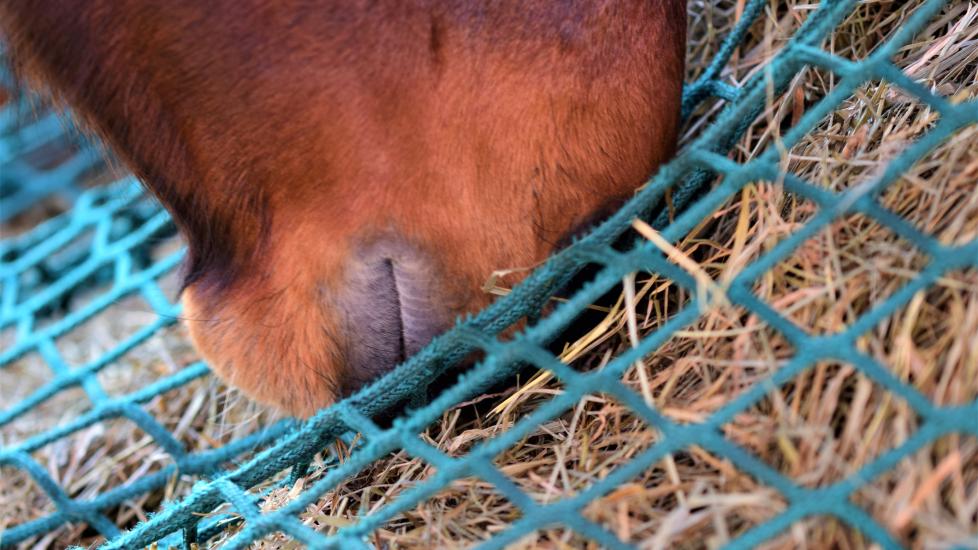Slobbers in Horses
What Is Slobbers in Horses?
Slobbers is the most common cause of hypersalivation (excessive salivation) in horses. Horse slobbers is caused by a fungus called Rhizoctonia leguminicola, which is commonly found in the soil and transmitted in seeds.
Slobbers is not life-threatening, and the symptoms typically resolve on their own if the horse is removed from the fungus.
Symptoms of Slobbers in Horses
-
Hypersalivation or excessive salivation
-
Excessive tearing
-
Frequent urination
-
Stiffness
-
Pregnancy loss
-
Loss of appetite
-
Bloating
-
Death
Causes of Slobbers in Horses
The Rhizoctonia fungus commonly lives in the ground and can be found on legumes such as red clover, white clover, and alfalfa. Specifically, this fungus thrives in environments that have high humidity, drought, and continuous grazing. Because of this, slobbers is often seen during the summer months for horses out on pasture. But it can also be seen in hay if the fungus was growing on the clover at the time of baling.
Hypersalivation occurs after a horse ingests the fungus. This specific fungus produces a toxin called slaframine. Slaframine is irritating and stimulates the horse’s salivary glands, causing excessive drooling.
How Veterinarians Diagnose Slobbers in Horses
Generally, slobbers can be diagnosed based on physical exam and history of your horse’s health. While slaframine ingestion is the most common reason for excessive salivation in horses, it’s always best to have your veterinarian do an exam to rule out other conditions.
An oral exam can make sure there are no foreign objects stuck in the horse's mouth or injuries to the tongue or gums that could cause increased salivation. Other medical conditions such as choke, neurologic conditions, and toxins including black walnut and acorns can lead to excessive salivation.
Treatment of Slobbers in Horses
Slobbers is not typically life-threatening; it’s more of a nuisance to horse owners. Treatment for slobbers is often just removing the horse from the infected pasture, replacing the affected hay, or mowing the pasture down.
The excessive salivation should be mitigated within a few hours of removing the infected food source. Providing the horse with fresh water can help prevent dehydration caused by the increase in salivation.
Recovery and Management of Slobbers in Horses
Slobbers generally resolves quickly after the horse is removed from the infected legumes. Horses recover quickly with little to no side effects or other consequences.
But excessive salivation could possibly lead to dehydration, so always allow your horse access to fresh water. If a horse eats excessive amounts of the toxin, mouth ulcerations could potentially occur. If you are concerned that your horse may have ulcerations, it is best to call your veterinarian for an oral exam. Until they can be seen, remove the food source (pasture or hay) that has contaminated toxin.
Prevention of Slobbers in Horses
Prevention of slobbers from occurring may mean reducing the clover concentrations in the pasture by seeding with other grasses and using good pasture management practices. These practices include fertilizing, resting, and rotating the pastures.
Slobbers in Horses FAQs
How do you get rid of horse slobbers?
You can stop slobbers in horses by removing the fungus-infected food source. This can be done by removing the horse from the pasture or cutting down the pasture short.
Is slobbers bad for horses?
Slobbers is generally considered not life-threatening. Instead, it’s more of a nuisance.
What causes horse slobbers?
Slobbers is caused by a toxin called slaframine that is produced by the Rhizoctonia leguminicola fungus. It commonly infects legume plants that horses may eat.
How long does slobbers last in horses?
Slobbers typically lasts as long as the affected horse eats the infected food source. The excessive salivation will begin to slow a few hours after the horse is removed from the infected food source.
Featured Image: Anja Janssen/iStock / Getty Images Plus via Getty Images
